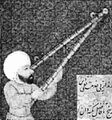Template:Selected anniversaries/March 4: Difference between revisions
No edit summary |
No edit summary |
||
| Line 106: | Line 106: | ||
||1967: Michel Plancherel dies ... mathematician. He worked in the areas of mathematical analysis, mathematical physics and algebra, and is known for the Plancherel theorem in harmonic analysis. Pic. | ||1967: Michel Plancherel dies ... mathematician. He worked in the areas of mathematical analysis, mathematical physics and algebra, and is known for the Plancherel theorem in harmonic analysis. Pic. | ||
||1970: French submarine Eurydice explodes underwater, resulting in the loss of the entire 57-man crew. | ||1970: French submarine ''Eurydice'' explodes underwater, resulting in the loss of the entire 57-man crew. | ||
||1976: Walter H. Schottky dies ... physicist and engineer. | ||1976: Walter H. Schottky dies ... physicist and engineer. Pic. | ||
||1977: The first Freon-cooled Cray-1 supercomputer, costing $19,000,000 , was shipped to Los Alamos Laboratories, NM, and was used to help the defense industry create sophisticated weapons systems. This system had a peak performance of 133 megaflops and used the newest technology, integrated circuits and vector register technology. The Cray-1 looked like no other computer before or since. It was a cylindrical machine 7 feet tall and 9 feet in diameter, weighed 30 tons and required its own electrical substation to provide it with power (an electric bill around $35,000/month). The inventor, Seymour Cray, died 5 Oct 1996 in an auto accident. His innovations included vector register technology, cooling technologies, and magnetic amplifiers. | ||1977: The first Freon-cooled Cray-1 supercomputer, costing $19,000,000 , was shipped to Los Alamos Laboratories, NM, and was used to help the defense industry create sophisticated weapons systems. This system had a peak performance of 133 megaflops and used the newest technology, integrated circuits and vector register technology. The Cray-1 looked like no other computer before or since. It was a cylindrical machine 7 feet tall and 9 feet in diameter, weighed 30 tons and required its own electrical substation to provide it with power (an electric bill around $35,000/month). The inventor, Seymour Cray, died 5 Oct 1996 in an auto accident. His innovations included vector register technology, cooling technologies, and magnetic amplifiers. | ||
Revision as of 09:59, 12 March 2019
928: Astronomer Abd al-Rahman al-Sufi uses Gnomon algorithm to solve crimes against astronomical constants.
1702: Thief Jack Sheppard born. He will be arrested and imprisoned five times in 1724 but escape four times from prison, making him a notorious public figure, and wildly popular with the poorer classes.
1821: Mathematician, physicist, astronomer, and crime-fighter Pierre-Simon Laplace publishes new class of Gnomon algorithm functions which detect and prevent crimes against mathematical constants.
1881: Physicist and chemist Richard C. Tolman born. He will make important contributions to theoretical cosmology in the years soon after Einstein's discovery of general relativity.
1931: US Navy says Carnivorous dirigibles cannot be tamed, should be put down.
2007: Mathematician Hing Tong dies. He made contributions to algebraic topology, including a proof of the Katetov–Tong insertion theorem.
2007: Math photographer Cantor Parabola publishes new class of Gnomon algorithm functions which uses time crystals to reveal centuries-old events.
2008: Game designer Gary Gygax dies. He co-created the pioneering role-playing game Dungeons & Dragons (D&D) with Dave Arneson.
2016: Cantor Parabola and Gnotilus at Athens hailed as "a triumph of art and crime-fighting." Parabola's work will influence a generation of mathematicians.








